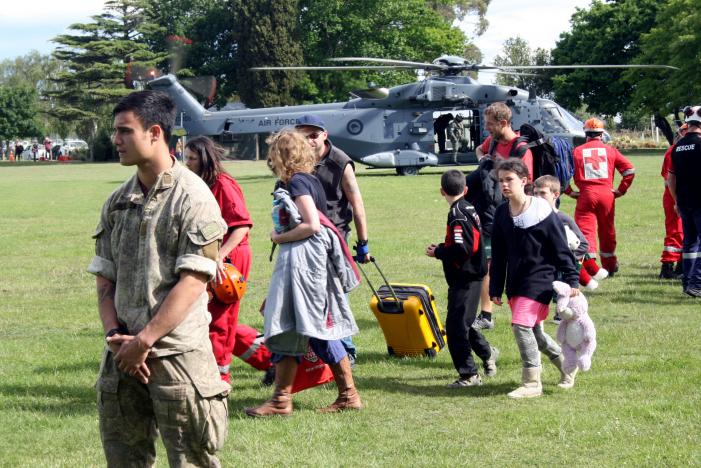New Zealand quake evacuees get food, shelter, wifi in Christchurch
CHRISTCHURCH: Hundreds of survivors stranded by a huge earthquake that struck central New Zealand three days ago reached Christchurch by a naval ship early on Thursday, as engineers in the capital, Wellington, assessed the state of dozens of damaged buildings.
Around 450 tourists and residents from the small seaside town of Kaikoura were taken by the New Zealand navy's multi-role vessel HMNZS Canterbury 150 km (90 miles) south to Christchurch, the South Island's largest city, overnight.
Most tourists had continued their journeys, but around 130 people were being housed temporarily in Canterbury University's student halls.
"They've set up to feed people, house people, they've got all the facilities they need," she said. "We've set them up with wifi, that was one of the things they were asking for."
Kaikoura, a fishing community and popular whale-watching base ringed by steep mountains, had been completely cut off by large landslides that covered road and rail links.
With damage expected to take months to repair, the government announced a NZ$7.5 million ($5.3 million) package to support small businesses in Kaikoura for two months.
"This is a situation where the whole of Kaikoura and surrounding towns are literally out of business," Economic Development Minister Steven Joyce told reporters.
"These companies ... are going to have a sustained reduction in their turnover to the point of almost nothing for a long period of time and that's why we think it's appropriate for the government to step in," he said.
Two people were killed and dozens injured by the magnitude 7.8 quake - two nearly simultaneous tremors that ruptured faultlines across the top of the ruggedly beautiful South Island.
The timing of the quake - shortly after midnight on Sunday - combined with the epicenter being in a sparsely populated region prevented a higher toll, authorities said.
STRUCTURAL DAMAGE
In Wellington, as many as 60 buildings suffered structural damage, including a multi-storey building near the parliament complex that would have to be taken down, engineers said.
Wellington is bisected by several fault lines, and large areas of its business district are built on reclaimed land, raising questions about building practices in the capital despite some of the world's strictest codes.
"There are some sites that are really not suitable for certain types of structures. For example, I would seriously question putting a hospital or essential services on reclaimed land," Paul Campbell, the president of the New Zealand Structural Engineering Society, told Radio New Zealand.
The force of the tremor was most evident in the upper South Island, where parts of the coast moved meters.
A team of volunteers rescued thousands of abalone, a large shellfish known locally as paua, that had been left high and dry.
A popular New Zealand fur seal colony near Kaikoura, where pups could often be seeing playing in a waterfall in a nearby stream, was destroyed by a landslide, Department of Conversation officials said.
Civil Defense evacuated some residents near the Hapuku and Ure Rivers, further north, where landslides from the earthquakes had blocked the rivers.
"There is a 150m high dam caused by the earthquakes which could rapidly fail, spilling water and debris from the new 'lake' over (or through) the dam due to heavy rain and building pressure," Civil Defence Canterbury said on its Facebook page.
Storms lashed the region on Thursday and seismologists were still recording hundreds of aftershocks - some 2,000 have rattled the region since the initial shock.
Government body Geonet Science estimated an almost one-in-three chance of another 7-7.8 magnitude quake hitting the region within the next 30 days.






